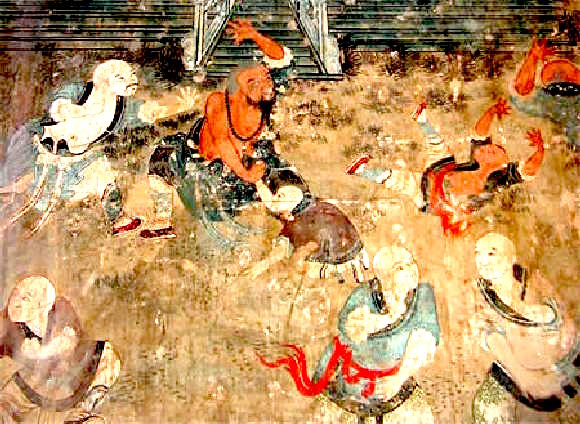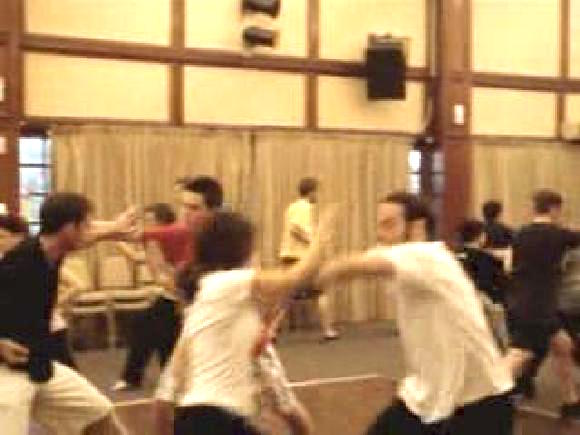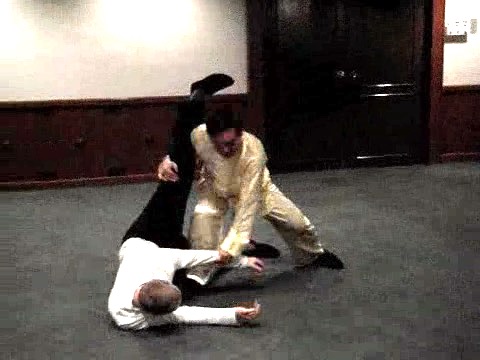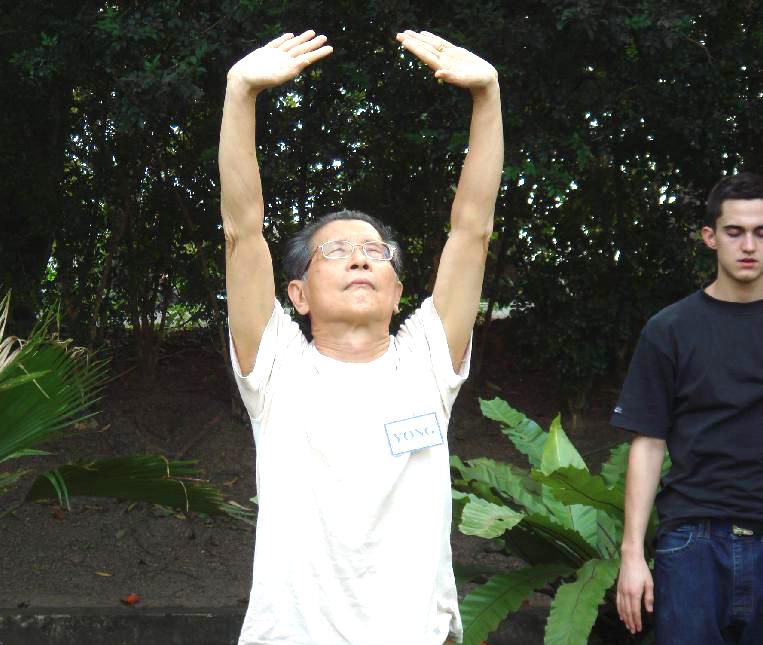August 2009 (Part 3)
SELECTION OF QUESTIONS AND ANSWERS

How did students in the Northern and the Southern Shaolin Temples spar? Like we do today, using Shaolin Kungfu of course.
Question 1
Sigung, could you please elaborate on the topics below? Have you any technical stories or photos of Sitaigong Ho's Siamese Boxing training?
— Sifu Jamie Robson, Scotland
Answer
My sifu, Sitaigung Ho Fatt Nam, was a professional Siamese Boxing or Muay Thai champion. It is significant to note that there is much difference in standard between a professional and an amateur. So we can have a good idea how good Sitaigung was in his Muay Thai fighting.
He told me that a professional Muay Thai fighter typically kicked at the trunk of an areca tree a few hundred times every day until the tree shook. This made his kicks very powerful and fast. But Sitaigung said that it was bad for health, it damaged the legs but Muay Thai professionals had to do so for survival. They depended on fighting to live. It was certainly not an enviable life, he said.
Worse, they had to put up with a lot of injuries. They had to win three or four rounds at the village level before they qualified for the district level. They also had to win three or four rounds at the district level to qualify for the regional level, and to win three or four rounds again to qualify for the national level. Not only they had to win, they must not be too badly injured in order to fight well. However, sometimes matches were fixed.
My sifu showed me some deadly techniques Muay Thai fighters used, and their counters. The best is what we now call his legacy, "Planting Willows in Front of Camp" to counter the formidable Muay Thai knee jabs. I am not sure whether my sifu used it in his Muay Thai fights or whether it was actually allowed according to Muay Thai rules. I remember many martial artists were weary of this Muay Thai attack and they did not know how to handle it. So I asked my sifu for the counter and he showed me the best.
I also remember very clearly that my sifu told me the kungfu counters against Muay Thai sweeping kicks shown in kungfu movies, which were very popular at that time, were unrealistic. Unless the defender had tremendous internal force, he said, blocking a Muay Thai sweeping kicks, which was popularly shown in movies, would result in the defender's arm being fractured.
So how does one, especially an elegant lady, defend against these powerful Muay Thai sweeping kicks that could sway palm trees. You know the answer very well, and have demonstrated it in your interesting Muay Thai Counters in our Virtual Kwoon.
Unfortunately I do not have any pictures of my sifu showing Muay Thai techniques. He gave up Muay Thai when he was quite young, soon after he had learnt Shaolin Kungfu from my sigung Yang Fatt Khun.
Question 2
How did Sitaigung Ho manage his students when free-sparring? Was there any form of protection? Was it 100% free?
Answer
Like kungfu practitioners in the past but unlike most martial artists today, we had little free sparring. We spent a lot of time on force training and combat sequences.
Nevertheless, when we free spar, there were no rules. It was 100% free. But we were very good at control. We stopped just an inch from target. In my many years sparring with my classmates, there were only two occasions when I was injured.
Once, my siheng, Ah Leong, held my leg as I kicked. I countered with a "straight-body" Tiger-Tail Kick, which actually was an excellent counter. But my siheng knew this very well, and he anticipated me. Before I could kick, he pulled my leg which he held, resulting in me falling face-on to the ground with blood over my face. It looked nasty, but the injury was only skin-deep.
The other injury, which I have described a few times, was very serious though it left no outward mark at first. My siheng, Pok Kai, executed a double punch using "Double Dragons Emerge from Sea". I gripped his two hands with double Tiger-Claws. It was a trap. He released the grip with a gentle twist and more gently tapped my chest with a vertical fist. I still remembered the incident clearly, an incident that put me out of action for about six months!
As soon as his fist gently hit my chest, he pulled back, and apologized sincerely and profusely. He said he thought I knew the trap and was ready for the counter. At that time I was still new to what internal force could cause. I told him it was nothing, as I felt nothing except the gentle tap. There was no pain at all, and no mark. So we continued sparring.
It was two days later that I felt something wrong. My eyes became yellowish and I could hardly speak. There was still no pain and no external marks. I consulted my sifu, and he confirmed it was an internal injury. He prepared some medicine for external application, and some herbal concoction for internal consumption.
After a few days some faint purple colours surfaced on my chest. The colours gradually became darker and darker until eventually they were almost black. It took me about six months to recover completely.
Today some students would think me fussy when I ask them to perform "Lifting the Sky" followed by chi flow, if I accidentally hit them very gently. I do not want them to be out of action for six months.
Our students today are very lucky. Even if they have been injured, if they have a vigorous chi flow immediately they can flush out the injury. If the injury has been there for a few days, they may need vigorous chi flow for a week or two to recover. Chi flow is excellent for overcoming injuries.
Why didn't I performed vigorous chi flow at that time? It was not in Sitaigung Ho's repertoire and I had not learnt it yet.

Like the students of the Shaolin Temple in the past, we use Shaolin Kungfu in our sparring
Question 3
How did students in the Northern and the Southern Temples spar?
Answer
They sparred the way we now spar - no rules but a lot of control and also a lot of laughter and fun. Like us too, injuries were rare.
Certainly they used the techniques and skills they normally practiced. They did not bounce about like Boxers or Kick-Boxers. They used Shaolin Kungfu in their sparring and fighting. We know this for sure. Some of their sparring as well as actual fighting has been recorded in text and pictures.
Before I learned from my sifu (I was one of his last students), my sifu had an annual grand sparring competition to choose the best ten disciples. This was the tradition he followed from his own sifu, which in turn was the tradition in the southern Shaolin Temple in the past. I am not sure whether this was also the tradition in the northern Shaolin Temple. Unfortunately this tradition was discontinued before I joined my sifu's school.
Question 4
How did students cultivate to be comfortable under pressure, knowing they would be hit, maimed or killed? But knowing your partner will stop on or before contact may be less demanding.
Answer
There were no special methods in my sifu's school or in the Shaolin Temples in the past to cultivate students to be comfortable in sparring or fighting. By just practicing their arts the way they were taught, they would be relaxed and efficient in sparring or real combat.
It was not true that when they sparred with their classmates, they would be under pressure. They knew very well that their sparring partners would not hit, maim or kill them. They had complete trust in their sparring classmates, who were like their brothers.
This is the same with us today. Apart from our normal training, we do not need special methods to train to be relaxed when sparring with our classmates. We know that a Black Tiger or a Poisonous Snake could kill if it actually hits someone with full force, but in our demonstration we just freeze to allow our sparring partners to access their spacing, trusting them very well that they would stop the attack an inch or two away.
However, in a real fight, some of our less experienced students may be anxious or panicky. I believe this might also apply to the less experienced students in my sifu's school or the Shaolin Temples in the past.
The anxious and panicky feeling is due to a lack of real fighting experience. An effective way to overcome it is to gently sink the chi to the dan tian. This, in fact, was what past masters did in real fighting, and what we do in our sparring practice. At the start of the fight, past masters sank their chi to their dan tian as they assumed their poise patterns.
If the anxious or panicky feeling still exists, then breathe out gently a few times while getting into the "four preparations". These methods will enable a combatant to be relaxed and focused so that he can give his best in combat.
When sparring with their classmates, our students are not stressful because, as you have rightly said, they know that even when they fail in their defence, their classmates will stop their attack on or before contact. But in a real fight or even friendly sparring with other people, our students may be stressful because they know they would not have this brotherly concern.
The numerous steps I have mentioned above will help them eliminate their fear or anxiety. But if they still have some fear or anxiety, the following thoughts would be helpful.
From their own experience in class sparring, they know that size is not important. Even when a sparring partner is twice his size, because of his internal force he can still handle his big-sized sparring partner comfortably. Hence, if he happens to meet a huge opponent in a real fight, he should think of the opponent as one of the big-sized classmates whom he can handle easily. This, in fact, was a very useful advice my sihengs told me years ago when I learn from Sitaigung Ho.
Secondly, apart from real masters and professional fighters, the striking power of martial artists today is really not much. This statement may make many people angry, but we are not afraid to state the truth for our students' benefit. Of course this does not mean we encourage our students to be arrogant and start accepting challenges, but it is meant to assure them so that they can be relaxed and confident if they ever happen to be in a real fight.
Considering the generous exchanges of blows in free sparring today, many martial artists would be dead by now if their strikes were powerful. So unless the strikes land on eyes, throats, groins or other vital spots, which our students must protect at all cost, being accidentally hit on the body a few times is really not a serious matter. This statement must be understood in its intended meaning. Our students must always adopt the combat philosophy that they should not be hit at all, not even once. Notwithstanding this, if they were being hit, it is not likely to be damaging. This thought would give them much confidence in real fights.
A third thought that would give much confidence to our students in real fights, is that they should aim at bringing down their opponents with just one or two strikes. This is in direct contrast with many martial artists today who generally throw punches and kicks wildly. We train our students to be kind even to our opponents and avoid hurting them as far as possible. But if the situation warrants it, our students must not be afraid to strike down an opponent with a decisive, powerful strike. This is being righteous and courageous, i.e. doing the right thing without fear.

"Planting Willow in Front of Camp" is a legacy of Patriarch Ho Fatt Nam to counter the formidable Muay Thai sweeping kicks or knee strikes
Question 5
I just finished reading your marvelous book "Chi Kung for Health and Vitality". I am practising Taiji Eighteen Steps since the past four months. I wish to supplement my practice with 2 of your practices - "Plucking Stars" and "Big Windmill" for my digestive problems (mild colitis and acidity). Is it ok?
— Dr Vikas, India
Answer
Yes, this is alright. Generally one can practice different chi kung exercises in the same training session, especially when the exercises are of the same chi kung category though they may not be of the same school. Both the chi kung exercises shown in my book, "Chi Kung for Health and Vitality", and Taiji Eighteen Steps belong to the same category of chi kung called "dao yin" or "dynamic patterns", though they belong to different schools. My exercises belong to the Shaolin school, whereas the other exercises belong to the Taiji school.
If the exercises are not of the same categories, they can still be practiced in the same session, unless in special situaitions when one type of exercises is not suitable for the practitioner, or when he may mess up the different exercises or in rare occasions when one categroiy of exercies may cancel the beneficial effects of the other exercises.
If a person is sick, for example, he should practice "dao yin" exercises. If he practices "Golden Bridge", which belongs to another category of chi kung called "zhan zhuang" or stance training, it may be too powerful for him. Or, as zhan zhuang exercises are different from dao yin exercises, he may mess up his practice with the result that he may not have any benefits. In dao yin exercises he generates a chi flow, but in zhan zhaung exercises he consolidates his chi. The opposite effects of the two exercises may cancel out their beneifts.
Nevertheless, if the practitioner is skillful, he may practice both dao yin and zhan zhuang exercies. Will these different exercises cancel out their benefits? No, they will enhance each other. Why is it that when a practitioner is unskillful, the different exercises may cancel each other's benefits, but if he is skillful the different exercises enhance the benefits? It is because an unskillful practitioner flows and then builds, or vice versa, whereas a skillful practitioner flows and builds at the same time.
As an analogy, an unskillful person saves up some money, then spends it away. In the end he has no money to spend and no money in his bank. A skillful person spends and saves at the same time. In the end his spending increases in volume, and his saving increases in volume too. This is one of many reasons why in our school, Shaolin Wahnam, we emphasize on skills.
Question 6
Isn't "Plucking Stars" similar to one of the exercises in the Eight Pieces of Brocade?
Answer
Yes, it is. "Plucking Stars" is one of the Eighteen Lohan Hands. The first eight of the Eighteen Lohan Hands are the same as the Eight Pieces of Brocade.

Lifting the Sky" to generate an energy flow is an excellent way to overcome internal injuries
Question 7
Since I started to practise Taiji Eighteen Steps I have noticed increased passage of gas. Is it a good sign?
Answer
Yes, it is a good sign. It shows that your practice has generated better energy flow that has cleared some blockage. The residue passed out of your body as gas.
In other cases the residue or toxic waste may pass out of the body in other ways, like bad breath, rashes or pimples on the skin, or even bad body smell.
Question 8
In fact I have been practising "Big Windmill" in the morning and it helps me in proper elimination.
Answer
Congratulations for your good result. Another useful exercise to help you overcome your digestive problem, irrespective of whether it is indigestion or purging, is "Merry-Go-Round".
Viewed from the conventional Western medical perspective, this may not make sense. How could an exercise that helps indigestion is also helpful for purging? This perspective is an example of dualistic thinking.
From the chi kung perspective, which is non-dualistic, it is perfectly sensible. The exercise generates better chi flow to the stomach and related organs. The chi flow clears the blockage that prevents the relevant organs to function properly. When the blockage is clear, the organs will function naturally. That means if there is indigestion, the relevant organs will produce the right chemicals to digest the food. If there is purging, the relevant organs will produce the right chemicals to stop the purging.
The same principle applies to similar situations. The same exercise may make a fat person lose weight, and a thin person put on weight. Better chi flow from the exercise will enable a fat person to produce the necessary chemicals to change his fat into energy, enabling him to be more proficient in his physical activities. For a thin person, the chi flow will convert his excess energy into mass giving him more weight.
When the weather is hot, by performing a chi kung exercise like "Plucking Stars" to generate chi flow, you feel cooler. This is because the chi flow has a "vaporizing" or cooling effect. On a cold day, by performing the same exercise to generate chi flow, you feel warmer. This is because the chi flow spreads heat over your body.
It is significant to note that one needs not know what chemicals will digest food or stop purging, or why chi flow has a cooling effect on hot days but a warming effect on cold days. These are natural processes. If you know how or why they work, that is fine. But if you don't know, the natrual processes still carry on. If the natrual processes do not work properly, it is because energy is blocked from doing its work. When the blockage is cleared, the natural processes resume.
LINKS
Selected Reading
- Some Special Advantages of Shaolin Wahnam Training
- Modernized Wushu is Different from Traditional Kungfu
- I Couldn't Ask for a More Wonderful Experience
- The Three External Harmonies of Footwork, Body-Movement and Hand Techniques
- Excellent Chin-Na Techniques for Felling and Controlling Opponents
